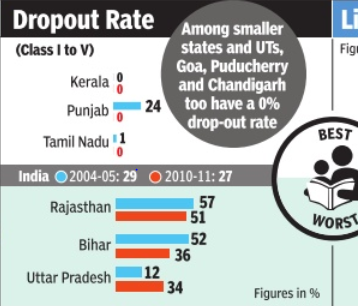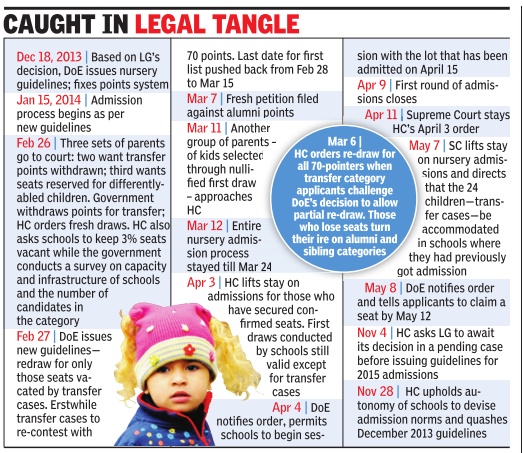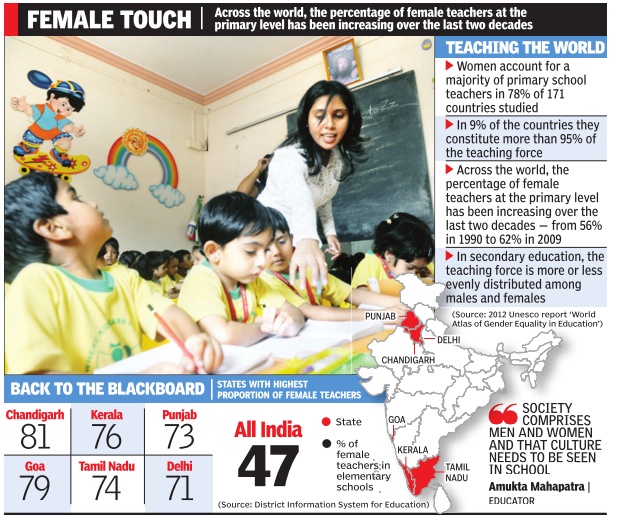Primary Education: India
This is a collection of articles archived for the excellence of their content.
|

Private-unaided school's autonomy
Schools happy, talk about self-regulation
New Delhi TIMES NEWS NETWORK The Times of India Nov 29 2014
The nursery nightmare is far from over with more court battles looming ahead. Sources say the government is gearing up to appeal against Friday's high court order “as soon as possible“. Lawyer-activists Social Jurist, whose case had put the onus of framing guidelines at the LG's door, will also file a plea. And finally , there's a case in Supreme Court on the applicability of Right to Education Act on nursery admissions, Khagesh Jha, a lawyer, told TOI. “The decision on this case could be a gamechanger“. However, none of that is curbing the enthusiasm of school associations that see the HC order as vindication of the “right to autonomy“ of unaided institutions. The restoration of management quota has been particularly welcomed. “This is a victory of the private-unaided school's autonomy as the order clarifies that government has no role and can't interfere in admission in these schools. But now we have to ensure there is no violation. We'll have to think how we can restore people's faith in private schools, we have to be more responsible, more transparent,“ said S K Bhattacharya, president, Action Committee for Unaided Recognized Private Schools, a co-petitioner. He said a committee will be constituted to frame a `common policy'. “We will self-regulate.“ Friday's order permits private-unaided schools to choose their own parameters and assign points out of 100, as they had been doing from 2007 to 2012. There won't be common criteria or fixed points. Calling it a “landmark judgment,“ Ameeta Mulla Wattal, chairperson, National Progressive Schools Con ference, said the order “takes into cognizance that Delhi is not ready for that kind of guideline or even implementation of the neighbourhoodschool concept as there aren't enough schools“. “We have to ensure that autonomy isn't misused,“ said R C Jain, president, Delhi State Public Schools Management Association, “The restoration of management quota is only fair. There are requests from various quarters and we need to oblige those who helped us set up the schools, but if someone is using it TO MAKE MONEY and there's a complaint, let the department take action“. He said last year's nursery mess was over a few schools that are in areas developed by DDA. “One size doesn't fit all and this year schools can once again create guidelines that best suit them, the areas they are in and the children who attend them.“ The court order “giving a free hand to schools“ has deeply disappointed Social Jurist. “The choice of the parent has prevailed but not the right of the child,“ said Jha.
Gender disparity in class
The Times of India, Jan 08 2015, Ramya M
Teaching in schools in some states in India is a female-dominated field. Close to 81% of teachers in elementary schools in Chandigarh are female, while Tamil Nadu, Goa, Kerala, Punjab and Delhi have women as more than 70% of their teaching force.
This is much higher than the national average of 47.2%. The figures are based on a National University of Educational Planning and Administration document titled `Elementary Education in India: Trends', prepared based on statistics compiled by all the states and Union Territories for the District Information System for Education.
Across the world, too, the percentage of female teachers at the primary level has been increasing over the last two decades -from 56% in 1990 to 62% in 2009, according to a 2012 Unesco document titled `World Atlas of Gender Equality in Education'. The document adds that in 9% of 171 countries, for which data is available, women constitute more than 95% of the teaching force. The report added that teachers’ pay is a factor in the proportion of female teachers. “The proportion tends to be high in places where teacher salaries are low. By contrast, males tend to dominate the teaching force in countries where teachers are relatively well paid,” the report said.
Local teachers said one of the main reasons for the gender disparity in the vocation is the low salary offered by private schools. Many teachers find that they get little in return for the amount of work put in.
Though government schools pay good salaries, urban private schools offer low salaries. So, it’s usually women who take up teaching jobs in these schools.
Academics said in rural areas, however, the scene is different.
Male teachers, who usually wait for a government job, sign up for one in the employment exchange and, while waiting, start a farm project or become real estate agents to earn a living. Once they get the job in a government school, many take it up and continue to get additional income by pursuing their other venture on the side.
Private school managements and parents also seem to prefer women as teachers. “Schools and parents prefer female teachers. It’s become something of a habit,” said Amukta Mahapatra, director of Schoolscape, a centre for educators.

